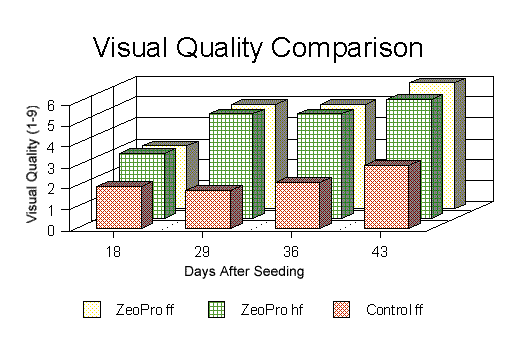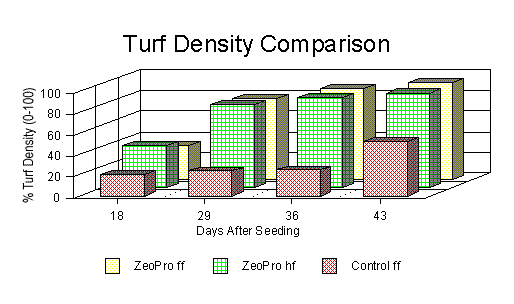Turf Establishment (Cornell) |
||||
A test was conducted at Cornell University to evaluate ZeoPro™ as an amendment for sand-based golf greens. Three replicate plots of each of two ZeoProTM treatments (amended into the sand at 10% by volume) were arranged in a completely random design. Plots consisted of 2 m diameter by 45 cm deep plastic containers fitted with a drain to collect leachate. The soil profile consisted of 15 cm of gravel at the base and 30 cm of the amended material. Control plots of sand/peat were also constructed to the same USGA specifications. The plots were seeded with creeping bentgrass (at a rate of 1 lb seed/1000 sq.ft with Penncross and L-94) on June 18, 1998. Fertilizers were applied on July 20, 1998 with ammonium sulfate as the N source and potassium sulfate for K applied at a rate of 28 kg/ha of N and K2O on the sand/peat control plots and 3 of the ZeoPro™ amended plots (ff). The other three ZeoPro amended plots were fertilized at a half rate (hf). Plots were irrigated for 5 minutes each hour from 6 am to 6 pm until plot cover reached 100% at which time a more moderate irrigation schedule was followed. |
||||
 |
||||
The effect of the ZeoProTM on visual quality during establishment is shown in the figure above. ZeoProTM dramatically improved quality (density, color and uniformity) as compared to the standard root zone material of sand-peat. The second figure below shows average turf density rating taken through August 1, 1998. The turf density of the ZeoProTM amended plots doubled from 18 to 29 days after seeding, whereas the turf density of the control plots only increased slightly during that time frame. From 29 to 43 days after seeding, the turf density of the amended plots was 2 to 4 times higher than the control plots. |
 |
| [ |
Copyright
2000 by ZeoponiX, Inc. and Boulder Innovative Technologies, Inc. |